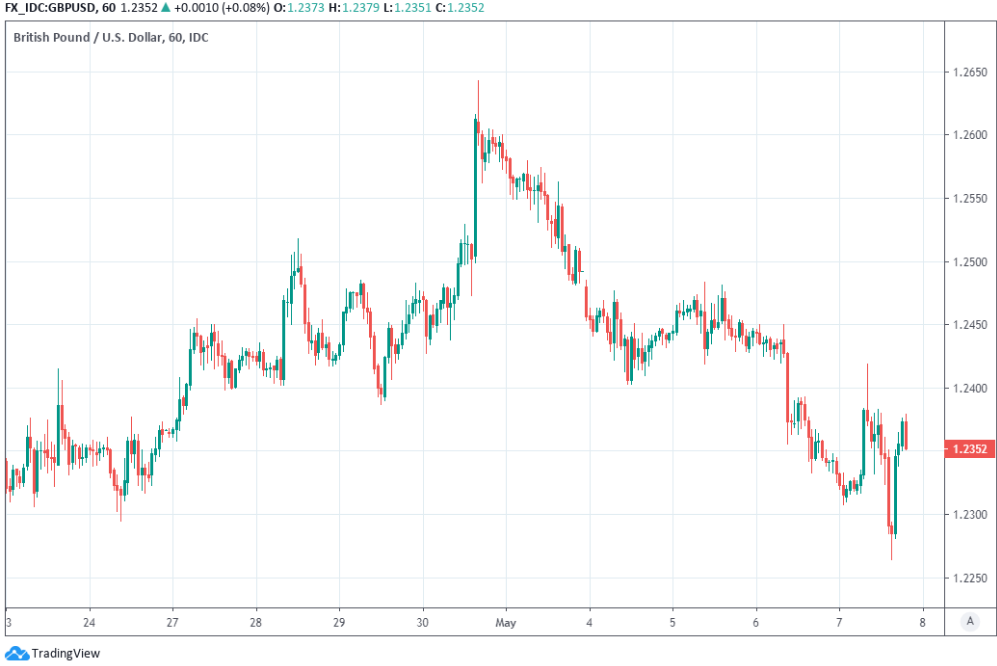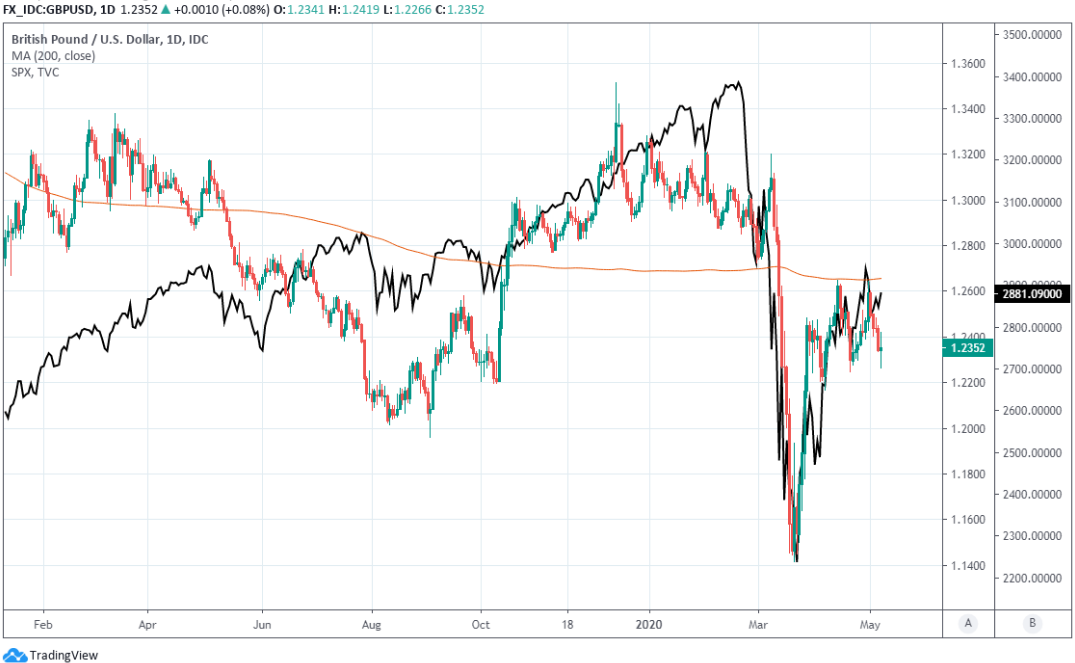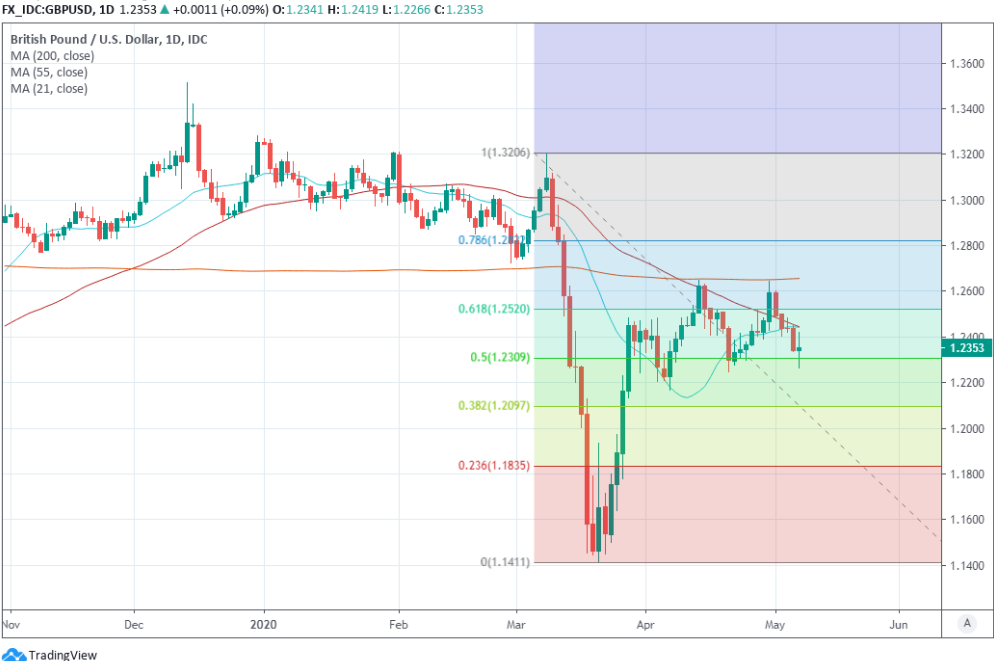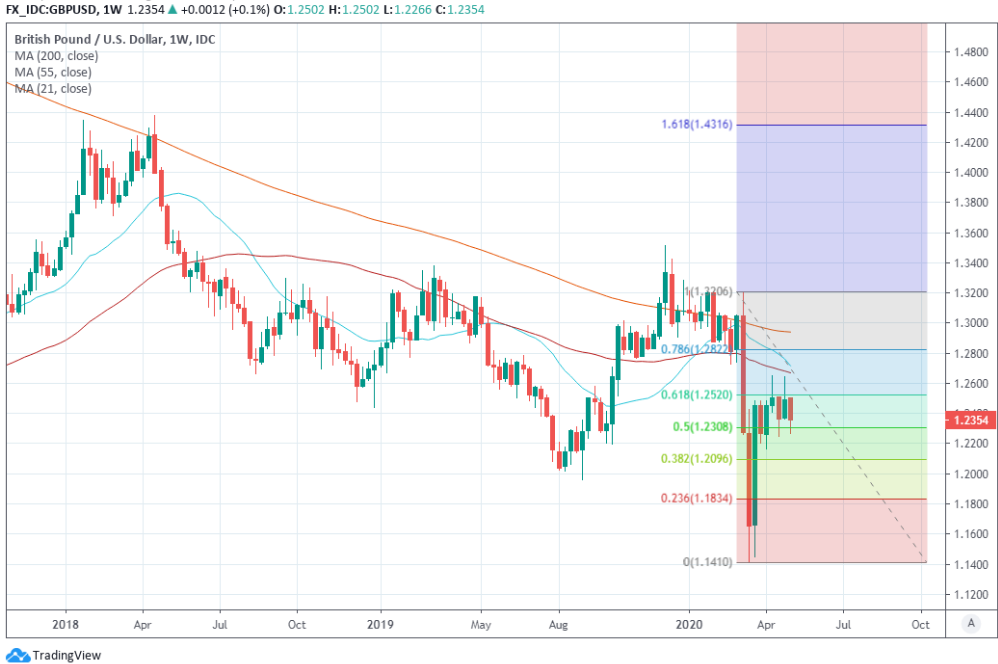Pound-Dollar Rate Hands Back Bank of England Boost, Eyes Trip South Ahead of Early Winter
- Written by: James Skinner
-
- GBP/USD hands back BoE boost following QE remarks.
- Bad weather ahead for GBP on fundamental headwinds.
- GB becomes 'sick man of Europe' as Brexit haunts GBP.
- Bearish charts flag spectre of trip South for early winter.

Image © Adobe Images
- GBP/USD spot at time of writing: 1.2357
- Bank transfer rates (indicative): 1.2034-2121
- FX specialist rates (indicative): 1.2172-1.2244 >> More information
The Pound-Dollar rate was unable to hold its Bank of England (BoE) boost ahead of the holiday weekend on Thursday and will face headwinds from multiple directions in the weeks ahead, at a point when the charts are also turning more clearly bearish again.
Pound Sterling got off to a fine start on Thursday after the Bank of England opted to leave all its monetary policy settings unchanged for the month of May and gave little indication of any further action being in the pipeline, enabling the British currency to rise alongside other proxies for risk appetite, which were lifted by better-than-expected trade figures from China and reports suggesting the world's two largest economies will work next week to implement the deal ending the 2018-2020 trade war between them.
But mid-session remarks from Governor Bailey put a break on the move higher, with the newly-appointed steward of monetary policy and the financial system saying in a press conference the bank could increase the size of its quantitative easing programme in June. This is a further headwind for British bond yields that would crush the returns of foreign investors in the developed world's largest current account deficit unless accompanied by a weaker currency.
"One could even argue that Governor Bailey's less gloomy tone helped GBP sentiment as well when he said "the recovery of the economy to happen over time, though much more rapidly than the pull-back from the global financial crisis". This is wishful thinking in our opinion and still largely dependent upon how the UK government eases lockdown measures, how much more UK health officials learn more about COVID-19 and how willing UK citizens/businesses will be to return to normal economic activity," writes Eric Bregar, head of FX strategy at Exchange Bank of Canada. "We think this is ultimately why sterling traders have pulled GBPUSD back towards session lows. The market made a short-term bottom at chart support in the 1.2310s last night, but it now looks poised to put pressure on this level once again as yesterday’s bearish head & shoulders pattern got confirmed, and looks even more pronounced now, given this morning’s upside reject of the 1.2400 handle."

Above: Pound-Dollar rate shown at hourly intervals.
Sterling had recovered sharply off multi-decade lows alongside other risk assets in the last six weeks as the near-indiscriminate damage wrought on the global economy by the coronavirus dominated the macro picture for investors, which saw the Pound-Dollar rate move in lockstep with the S&P500. But investors cooled their heels in late April so major benchmarks have lost momentum while many are now also facing technical roadblocks of the upside on the charts.
Investors might want to see figures supporting the notion of a robust global recovery before chasing stocks any higher, given the S&P was just -14% off its January record high on Thursday while the global economy remained largely at a standstill. However, and whatever the prospects of the U.S. stock index, the coronavirus tome is nearing its recovery chapter and that economic comeback will be discriminate in almost every manner which the virus itself wasn't.
“There is no real sign that our British friends are approaching the negotiations with a plan to succeed. I hope I am wrong, but I don’t think so,” European Trade Commissioner Phil Hogan was reported to have told RTE on Thursday, echoing last week's lamentations about only 'limited progress'. "My perception of it is they don’t want to drag the negotiations out into 2021 because they can effectively blame COVID for everything.”
Britain's economy and currency will arrive late to the starting line for the recovery because Prime Minister Boris Johnson is widely expected to extend the UK 'lockdown' until June, which could make the country the 'sick man of Europe' again. This risks seeing the Pound stick out like a sore thumb through May as others in Europe as well as the antipodean and North American countries each take tentative steps back toward normality in the weeks ahead.

Above: Pound-Dollar rate at daily intervals, moving in lockstep with S&P 500 stock index (black line) until this week.
In addition and by the time the UK officially reopens, the Brexit ghost may have returned to haunt Sterling if the latest EU summary is anything to go by. The Pound-Dollar rate fell to 1.20 the last time an 'Australia deal Brexit' was becoming a viable possibility while the Pound-Euro rate fell near to 1.05.
"Insofar as the UK carries a significant current account deficit, it is useful to view the outlook for GBP through the eyes of a potential inward investor. Criticism of the UK government in the international press is not helpful for the pound. Nor is last month’s news that the latest round of post-Brexit talks between the UK and the EU did not go well," warns Jane Foley, a senior FX strategist at Rabobank.
The Brexit talks are barely three rounds in and have stalled after opening gambits saw Brussels play immediately for an extension of the 'transition period' while Westminster insisted the whole thing be an affair between two sovereign equals. The British refused the extension and the Europeans scoffed at London's own take on a 'level playing field,' while both had less than eight weeks on Friday to extend an end-June deadline for requesting a transition extension or face seeing markets grow concerned about the prospect of something like an 'Australia deal Brexit' playing out at year-end.
An 'Australia deal Brexit,' would see UK and European Union goods exports subjected to tariffs in both directions and might over time lead to a divergence of laws and regulations that amount to 'non-tariff barriers' in some areas. Economists have always said this would wound the economy in the short-term and impair the country's long-term growth prospects however, and in the new coronavirus-plagued world of 2020, the upfront economic cost of a move to World Trade Organization terms from December 31 might struggle to be heard through the din of the rebound from 2020's sudden economic stoppage.

Above: Pound-Dollar rate roadblocked by 200-day moving-average and 61.8% Fibonacci retracement of 2020 downtrend
before falling back below the 55-day and 21-day moving averages.
"We see GBP remaining vulnerable based on our expectation there will be an extension to the QE programme at next month’s MPC meeting coupled with the fact that Brexit risks remain and due to the fact that the UK government has come under a hail of criticism for its handling of the coronaviruss," Foley says. "In view of both economic and political risks in the UK we expect GBP to push lower. We see scope for a dip towards GBP/USD 1.19 on a 3 month view."
The Bank of England said Thursday the economy would likely shrink by -3% for the first quarter and -25% for the second quarter, leading Britain to a -14% fall in GDP for 2020 and its worst year since before the 1706 Act of Union that joined England and Wales with Scotland. However, this is expected to give way to a rebound of up to 15% the next year in 2021. The numbers aren't forecasts but are intended to highlight one scenario the bank considers to be likely.
However, and as much as a rebound out of the coronavirus trough may paper over any Brexit impact on official figures, it won't necessarily stop the Pound from fretting about the long-term impact on growth. Nor will it prevent corporates from hedging the possible Brexit downside in Sterling, which risks making a self-fulfilling prophecy of currency losses, according to Societe Generale. This is the fundamental backdrop as the charts indicate that Sterling might be contemplating another trip South ahead of a possible early winter.
"GBP/USD has started to erode the near term uptrend at 1.2358 and failure here targets the 21st April low at 1.2247. This is negative price action and failure at 1.2247 would push the current April low at 1.2163 to the fore. A drop below there is needed to alleviate upside pressure and refocus attention on 1.1491, the 2016 low, and also the March low at 1.1409. Rallies will find initial resistance at 10.2437/45 (55 day ma) ahead of the 200 day ma at 1.2651," says Karen Jones, head of technical analysis for currencies, commodities and bonds at Commerzbank, who advocated to the bank's clients on Friday that they sell the Pound-Dollar rate at 1.2369 and again if it hits 1.2400.

Above: Pound-Dollar rate roadblocked by 61.8% Fibonacci retracement of 2020 downtrend for two months to May 07.










